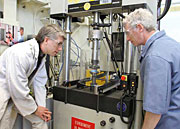- Number 340 |
- June 27, 2011
LLNL researchers identify simple way to mitigate traumatic brain injury

LLNL researchers Mike King (left)
and Willy Moss (right) test the
impact response of a helmet pad
system.
Using computational models and computing resources originally developed for its nuclear weapons/stockpile stewardship mission, researchers at DOE's Lawrence Livermore National Laboratory have identified a way to help protect U.S. troops from traumatic brain injury (TBI). Specifically, physicist Willy Moss and engineer Mike King found that a switch to thicker pads in one-size-larger military helmets can potentially reduce the severity of TBI from blunt and ballistic impacts. (Moss and King¹s previous work on blast-induced TBI was published in Phys. Rev. Lett. 103, 108702, 2009.)
The one-year study, funded by the U.S. Army and the Joint IED Defeat Organization (JIEDDO), assessed the effectiveness of five helmet pad systems‹those currently and previously used in the Army¹s Advanced Combat Helmet (ACH), two used in NFL helmets, and one used in other protective sports equipment. A combination of experiments and computational simulations was used to study the response of the various pad systems to battlefield-relevant impacts to gain an understanding of how helmet pads provide protection against blunt and ballistic impacts.
The LLNL researchers found that for comparable thicknesses, none of the pads examined outperformed the pad currently used in the ACH system for battlefield-relevant impacts. Even more important was the finding that significantly increased protection could be attained by modest increases in pad thickness.
The current military pad is about three-quarters of an inch thick. Moss and King found that increasing pad thickness by an extra eighth to quarter inch could make a large difference in reducing the accelerations imparted to the head. Implementing such a change would require no "system reconfiguration" but simply the use of a one-size-larger helmet with correspondingly thicker pads. Use of a one-size-larger helmet also would provide additional protection against non-penetrating bullets or metal fragments, due to the extra space into which the inside surface of the helmet could expand without contacting the head.
JIEDDO continues to work with LLNL to examine thicker pad systems with the intent of further protecting soldiers against impact and blast injuries caused by improvised explosive devices.
For an interview with Moss and King, see the ABC TV (KGO) report. LINK:
http://abclocal.go.com/kgo/story?section=news/health&id=8080536
[[Lauren Devore, 925.422.0855,
devore1@llnl.gov]
